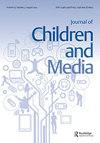Love and sexual scripts: A content analysis of 19 Netflix teen series
IF 2.1
3区 心理学
Q2 COMMUNICATION
引用次数: 0
Abstract
ABSTRACT Since 2015, Netflix has been one of the largest holders of teen viewers, greatly surpassing cable TV and other streaming platforms. This study focused on depictions of romantic love on screen, how these scenes intersected with sexual scripts, and the gender initiation and reception of this material. A content analysis was performed on 19 Netflix original series, which were coded using categories influenced by sexual script theory and adapted from Dillman Carpentier: loving language, loving behavior, sexual language, sexual behavior, and sexual health. Results found instances of loving or sexual content in each episode. Both loving and sexual language were the predominant aspects with sexual health instances in a few episodes. Included in the findings is a focus on loving language scripts that focus on ending a relationship rather than building or maintaining a relationship which has implications for teen expectations. Gender initiation and reception was largely equal across the five categories indicating a shift in gendered scripts. This study addresses the limited research within Netflix original series and furthers how sexual script theory understands the connection between loving and sexual content in teen programming. IMPACT SUMMARIES Prior State of Knowledge: Previous research has found that sexual scripts on television follow the traditional heterosexual script, with men as the pursuers and women being more emotional. Often, teen programming is more likely to show committed relationships, separating casual and committed sexual relationships. Novel Contributions: Our findings suggest that within Netflix teen programming, men and women are equally likely to initiate loving or sexual behavior. Programming is also more likely to see scripts skewed toward ending relationships rather than toward building healthy relationships. Practical Implications: Romantic and sexual scripts in television can influence teenagers’ expectations of relationships, including sexual health behaviors. Parents and educators should be aware of the romantic language and behavior dynamics shaping viewers’ perspectives, specifically given the lack of safe sex depictions.爱情与性剧本:19部Netflix青少年电视剧的内容分析
自2015年以来,Netflix一直是青少年观众人数最多的平台之一,大大超过了有线电视和其他流媒体平台。这项研究的重点是银幕上对浪漫爱情的描绘,这些场景如何与性剧本相结合,以及这些材料的性别启蒙和接受。本文对Netflix的19部原创电视剧进行了内容分析,采用了受性剧本理论影响并改编自Dillman Carpentier的分类编码:爱的语言、爱的行为、性的语言、性的行为和性健康。结果发现,每一集都有爱情或性的内容。爱的语言和性的语言都是主要的方面与性健康的情况下,几集。研究结果还包括对爱的语言脚本的关注,这些脚本关注的是结束一段关系,而不是建立或维持一段关系,这对青少年的期望有影响。在五个类别中,性别启蒙和接受基本上是平等的,这表明性别脚本的转变。本研究针对Netflix原创剧集的有限研究,并进一步探讨性剧本理论如何理解青少年节目中爱与性内容之间的联系。先前的研究发现,电视上的性剧本遵循传统的异性恋剧本,男人是追求者,女人更情绪化。通常,青少年节目更倾向于展示忠诚的关系,将随意的性关系和忠诚的性关系分开。新颖的贡献:我们的发现表明,在Netflix的青少年节目中,男性和女性发起爱或性行为的可能性是一样的。编程也更有可能看到脚本倾向于结束关系,而不是建立健康的关系。实际意义:电视中的浪漫和性剧本会影响青少年对关系的期望,包括性健康行为。父母和教育工作者应该意识到浪漫的语言和行为动态塑造了观众的观点,特别是考虑到缺乏安全的性描写。
本文章由计算机程序翻译,如有差异,请以英文原文为准。
求助全文
约1分钟内获得全文
求助全文

 求助内容:
求助内容: 应助结果提醒方式:
应助结果提醒方式:


